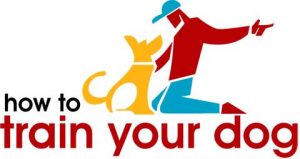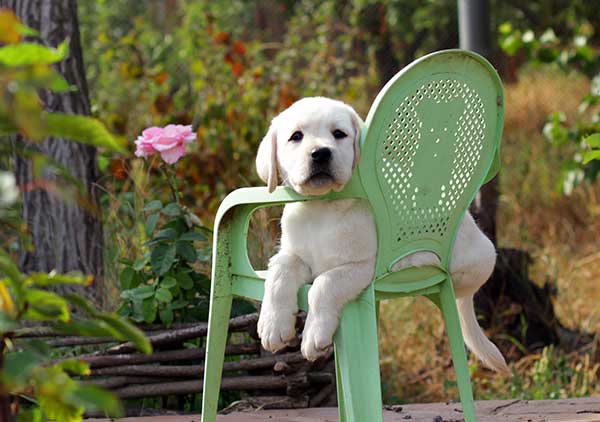If you are the happy new pet parent of a large breed puppy, you may be wondering how much exercise your new canine BFF should be getting. What exactly constitutes too much exercise or not enough?
It’s important to consider that big breeds need to avoid excessive exercise. This does not mean they should take it easy but selecting the correct type of exercise can go a long way in aiding the overall health and development of your pup.
Dogs love to please their person or persons, so it will be up to you as a new owner to keep an eye out for their welfare and not allow over-exertion even if your pup is a bundle of energy.
The temptation to wear down that seemingly endless source of potentially destructive behavior is strong, but quantity is not necessarily synonymous with quality. Large breeds do have tendencies toward specific health issues that excessive exercise can exacerbate.
A well-balanced diet for growing pups such as the protein-rich recipes provided by Timberwolf Organics, regular check-ups, and correct exercise will make you proactive in protecting your dog’s overall health. So, what’s the plan?
Table of Contents
How Much is Too Much When it Comes to Exercising Large-Breed Puppies?
Regardless of what breed of puppy you have or if your dog is a mixed breed, larger dogs are susceptible to joint and bone problems.
Even if you have a large mutt featuring characteristics of multiple breeds, as a large canine it will be susceptible to hip dysplasia just like purebreds and several other health issues known to plague larger dogs. When exercising your puppy, keep this consideration in mind.
While no given rule exists for a definitive amount of daily exercise, wouldn’t it be great to have a reliable rule for every breed? It would seem, nonetheless, that most of the experts agree, whether veterinarians, trainers, or breeders, that too much exercise is equally as bad as too little exercise.

The Basics
Large puppies may exhibit quicker growth. What was a little bundle of joy yesterday, is no longer a lap dog today.
Larger canines, do in fact, require more time to complete their development. A good rule of thumb to follow is: the younger your puppy is, the shorter your exercise period should be.
Undoubtedly, a five-month-old Labrador or Shepherd might be able to accompany you on a long walk or hike, but they shouldn’t. Different breeds will also demonstrate different tolerances to physical exercise. An energetic Labrador will most probably have a higher tolerance for exercise than say a Saint Bernard.
Consider that larger dogs need approximately a good fifteen months to be physically fully grown, so intensive training and activities requiring considerable exertion should be avoided during the puppy stage to prevent more serious health issues later on.
Hiking on rough terrain or agility training should be postponed until your pup is fully developed. Research shows a correlation between excessive exercise and orthopedic disease in the large-breed canines.
Take the time to learn as much about your puppy’s breed as possible, including the breed characteristics of the parents of mixed breed dogs.
Puppies also need to nap a lot. So, if your pup is pooped out, let Pooch rest. Your dog’s body will let him or her know if a nap is necessary.
Fully Formed Bones and Impact
One of the reasons that experts suggest limiting exercise and avoiding specific types of exercise until bones are fully formed, is that bone growth will begin in a point known as the epiphyseal plate. This is commonly called a growth plate.
Growth plates, when viewed on x-rays, appear similar to a fracture for the untrained eye or as horizontal lines; once a dog’s bone has fully matured, this line will no longer be apparent. It’s necessary that growth plates have the opportunity to complete their development before any type of exercise involving impact is undertaken.
Overly hard surfaces such as cement or asphalt should be avoided in favor of grass or dirt surfaces. Jumping of beds, couches, chairs, or similar should also be prevented while growth plates are still developing.
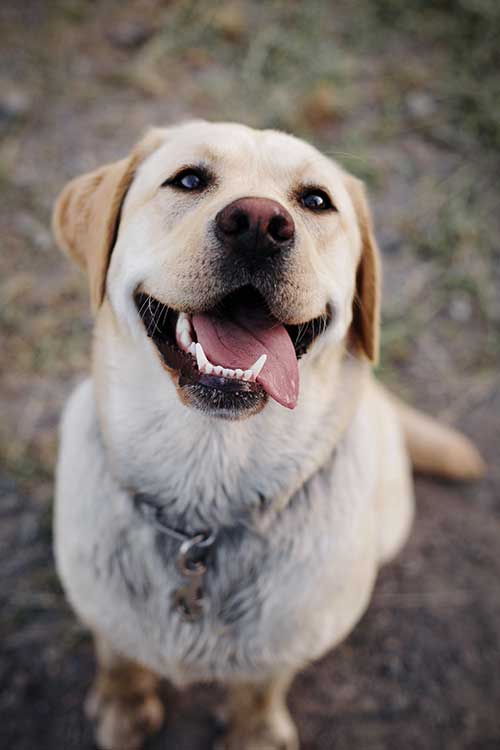
Too Little Exercise
Too little physical exercise is just as bad as too much and can lead to worse consequences as your dog ages. If your dog gets used to not exercising and being physically active, he or she is equally at risk for serious health issues such as weight gain.
Becoming overweight is one of the principal risks associated with too little movement. Severe weight gain and obesity lead to joint issues, cardiac issues, and diabetes to name just a few.
A lack of exercise can also be the reason behind destructive behavior due to pent up energy and general restlessness. An overexcited pup may be a sign of too little exercise.
Large-Breed Puppy Exercise Tips
To safely learn to recognize your puppy’s needs in terms of exercise, there are a few things you can start off doing safely.
1. Teach your puppy to walk correctly on a leash. Leashes are viewed as just about everything else in the immediate vicinity, i.e. a toy!
If you have difficulty teaching your pup to walk on a leash, a qualified dog trainer can start you off with the correct methods, and all the time your pup will be exercising.
Your pup should not be fixating on the leash but you. As pups will have very short attention spans, carry treats and work on basic commands like “sit” during your leash training. Your pup should walk at your side and a step slightly behind you, so there’s a lot to work on.
2. Begin with very short walks that are taken at a slow, relaxed pace. Do not bring a puppy jogging with you until it has reached at least six months of age. And even then, jogs should be short until your dog hits the 15-month milestone.
3. Avoid walking in extreme temperatures when very hot or very cold. On very hot days consider early morning or evening hours.
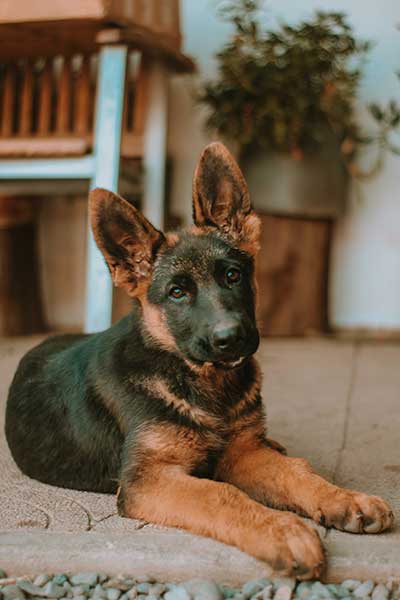
Other Methods of Exercising with a Large-Breed Puppy
There are several other ways to engage your large-breed puppy in play with the scope of helping your pup get enough exercise.
1. Give your puppy toys to play with as they love to play. Chew toys are especially indicated as your pup will be developing puppy teeth when about a month and a half old, and then at roughly three months, permanent adult teeth. This means that he or she will feel the urge to chew on everything.
For the first months get appropriate teething toys and then gradually replace them with chew toys.
2. “Go fetch” is a good way to begin teaching your puppy commands. If the dog sits or lays down, it’s time for a break. For pups younger than six months of age, games should not last more than ten minutes tops.
3. “Tug-of-war” is a canine favorite, but careful with the new teeth. Your pup should be the one tugging, not you.
4. Swimming is a possibility for large breeds if your pup likes the water. You should however be in the pool with your dog at all times, and if touching the pool bottom isn’t possible, a life vest is a must.
5. Obedience lessons, while not high-calorie burners, still involve physical activity. Basic command lessons should not last more than ten minutes each time and should not be repeated more than two or three times daily after a significant rest period.
6. Mental Stimulation will be a necessity for shepherding or working dogs like German Shepherds or Border Collies. These working breeds exhibit high-drive making mental stimulation just as important as physical exercise.
Plan work training sessions with your dog that include interactive games such as puzzle toys or olfactive discrimination exercises. These will keep your pup moving but in such a way as to limit physical stress while exercising.
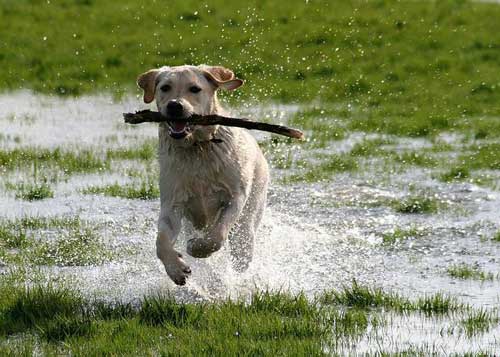
There is no specific rule that works for every dog. Observing your puppy closely will help define how much exercise he or she can handle without overexerting. Know that puppies can easily nap 18 hours in 24 hours, so you won’t be playing or exercising that much anyway.
Also remember that your puppy’s exercise needs will be subject to revision as he or she grows. Pups that are at least six months old will be able to walk for longer periods and participate in a short jog. The length can be gradually increased with each month of development.
Hikes on challenging terrain, however, should be postponed until your dog reaches the 15-month milestone. Some dogs even require a full two years to mature completely.
As a rule of thumb, high-energy and impact exercise should never last more than a maximum of ten minutes, and with pups under six months of age, two to three times daily will be more than adequate.
Start by consulting your veterinarian. Your pup’s vet will be in the best position to guide you in daily exercise requirements and when and how to increase exercising.
Short walks and lots of play breaks should do the trick!
Checkout Our Favorite Dog Products
1. BEST PUPPY TOY
We Like: Snuggle Behavior Toy with Heart Beat & Heat Pack – Ideal toy for new puppies.
2. BEST DOG TRAINING PROGRAM
We Like: Doggy Dan The Online Dog Trainer – Stop any dog problem and raise the perfect puppy with The Online Dog Trainer.
3. BEST DOG PUZZLE TOY
We Like: Outward Hound Interactive Puzzle Toy – Every dog loves chasing squirrels at the park. The Outward Hound Hide-a-Squirrel Puzzle Toy gives your dog the same feeling as though he was outdoors chasing live squirrels.
4. Best Bone Broth for Dogs
We Like: (Solid Gold – Human Grade Bone Broth for Dogs) – Simmered Beef Bone Broth With Turmeric Provides A Nutrient-Dense And Flavorful Addition To Your Dog’s Meal + Rich In Natural Collagen From Beef Bones.
5. Best Multivitamin for Dogs
We Like: PetHonesty 10-For-1 Multivitamin – 10 Benefits in 1 Daily Treat – These Multivitamin Snacks combine a well-rounded blend of the most essential vitamins and supplements including glucosamine, probiotics, vitamins and omegas, for dogs’ overall daily health.
